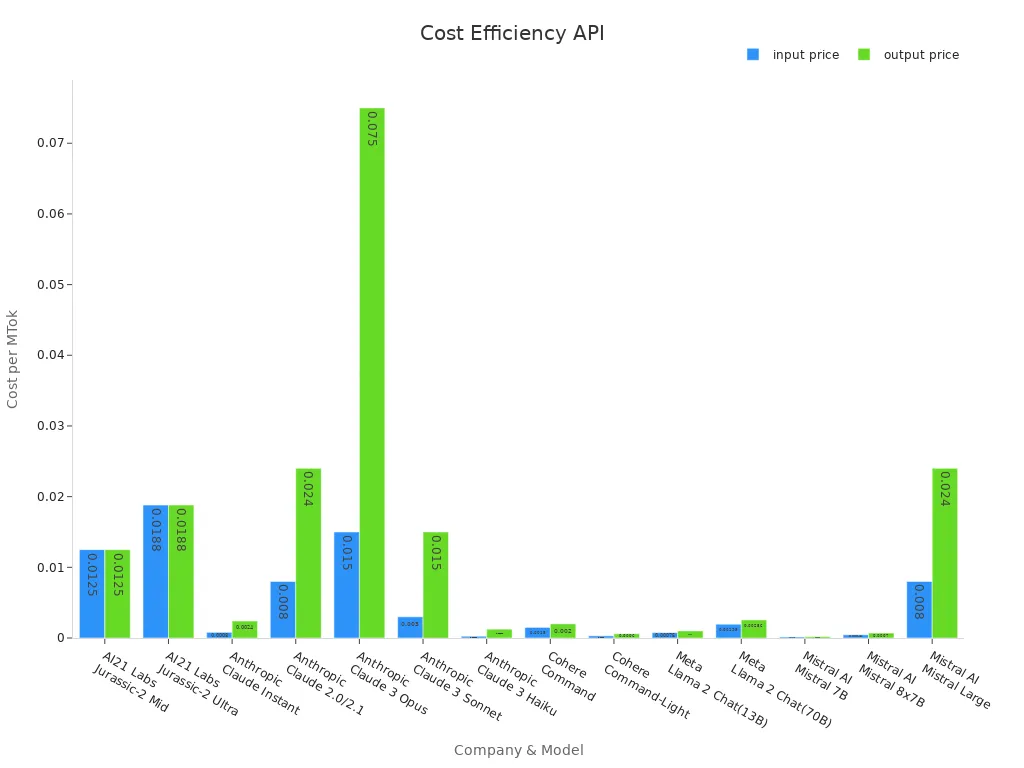
Choosing the right text generation API for 2025 matters more than ever. Recent advancements, such as Grok-3 models trained on xAI’s Colossus supercluster, show how far AI capabilities have progressed. These models excel in complex tasks, handling up to 1 million tokens in a single context window. To evaluate APIs effectively, focus on performance metrics like BLEU and ROUGE, as well as cost efficiency and scalability.
Key Takeaways
-
Pick a text tool that matches what you need. Check scores like BLEU and ROUGE to get good results.
-
Adjusting tools is important. Find APIs that let you change models to match your tasks. This helps you work better and get better results.
-
Look at prices closely. Compare costs with output quality to choose the best deal for your work.
Key Comparison and Considerations for Text Generation APIs
Model Capabilities and Performance
When evaluating text generation APIs, you should prioritize model capabilities and performance. Generative AI models differ significantly in their ability to produce coherent, contextually relevant, and high-quality outputs. For instance, OpenAI's GPT-4 excels in advanced performance metrics, while Microsoft Azure AI offers enterprise-grade features like compliance with security standards.
Performance metrics such as BLEU and ROUGE scores are essential for benchmarking. Studies show that larger models with more parameters, like GPT-Neo, outperform smaller models in contextual understanding. For example:
-
GPT-Neo demonstrated superior performance on vaccine-related datasets compared to GPT-2 and XLNet.
-
BLEU scores validated its ability to generate coherent and contextually accurate text.
These metrics highlight the importance of choosing a model that aligns with your specific needs, whether for content creation, sentiment analysis, or entity recognition.
Customization and Flexibility
Customization plays a critical role in tailoring generative AI solutions to your unique requirements. Leading APIs offer varying levels of flexibility, allowing you to fine-tune models or integrate them into existing workflows. Case studies illustrate this well:
|
Case Study |
Description |
|---|---|
|
Alibaba’s AI-Powered Copywriting Tool |
Generates up to 20,000 lines of content per second, adapting to context and tone for marketing copy. |
|
Insurance Claims Management |
Summarizes lengthy applications, speeding up decision-making in claims processing. |
|
Associated Press Automated Financial Reports |
Converts financial data into coherent reports, increasing efficiency by 15 times. |
These examples demonstrate how customization can enhance productivity and improve outcomes across industries.
Scalability and Reliability
Scalability and reliability are non-negotiable when selecting text generation APIs. You need a solution that can handle increasing workloads without compromising performance. Key metrics to consider include:
-
Training Time: Faster training enables quicker deployment of models.
-
Inference Time: Real-time applications demand low latency for seamless user experiences.
-
Resource Utilization: Efficient memory and processing power usage reduce operational costs.
Performance metrics like BLEU and ROUGE, combined with human evaluations, ensure that generative models maintain high standards of quality and reliability. As APIs evolve, innovative evaluation methods further enhance their scalability and dependability.
Pricing Models and Cost Efficiency
Understanding pricing models is crucial for managing costs effectively. Text generation APIs often charge based on token usage, API call volume, and context window limits. Here's a comparison of pricing across popular providers:
|
Company |
Model |
Input-MTok |
Output-MTokValue |
|---|---|---|---|
|
AI21 Labs |
Jurassic-2 Mid |
$0.0125 |
|
|
Anthropic |
Claude Instant |
$0.0008 |
$0.0024 |
|
Meta |
Llama 2 Chat (13B) |
$0.00075 |
$0.001 |
|
Mistral AI |
Mistral 7B |
$0.00015 |
$0.0002 |
For example, a startup using AI21 Labs' Ultra model may face higher token costs but benefit from reduced rewrites due to superior output quality. This highlights the importance of balancing direct and indirect costs when evaluating cost-effectiveness.

Documentation and Developer Support
Comprehensive documentation and robust developer support significantly impact the ease of integration and utilization of AI APIs. According to research:
-
58% of technical communication teams currently document APIs.
-
21% of these teams use Markdown for documentation.
Clear documentation simplifies the onboarding process, while active developer communities provide valuable resources for troubleshooting and optimization. When choosing an API, prioritize those with detailed guides, tutorials, and responsive support channels to ensure a smooth implementation process.
Overview of Leading Generative AI Platforms

OpenAI API
OpenAI API remains one of the most popular generative AI platforms globally. Its flagship model, GPT-4, excels in natural language understanding and generation, offering a conversational style that feels human-like. You can rely on its extensive training dataset, which spans over 570GB and supports nuanced interactions across more than 20 languages. This makes it ideal for multilingual applications.
Performance metrics highlight its strengths: average response latency is around 100ms, enabling real-time applications. Businesses benefit from seamless integration with existing software ecosystems, reducing implementation time. Customization options allow you to adjust tone and style to match your brand voice, making it a versatile choice for marketing, customer support, and more. Surveys conducted by OpenAI show user satisfaction rates exceeding 90%, with a 15% increase in user retention post-update.
Tip: If your project demands high-quality conversational AI with real-time capabilities, OpenAI API is a reliable option.
Google Cloud AI (PaLM)
Google Cloud AI’s PaLM platform stands out for its multilingual capabilities, supporting over 100 languages. It offers specialized versions like Codey for coding tasks, making it a strong contender for software development applications. You’ll find its seamless integration with the Google ecosystem particularly advantageous, especially if you already use Google Cloud services.
Here’s how PaLM compares to other generative AI platforms:
|
Metric |
Google Cloud AI (PaLM) |
Other Models (LLaMA 2, GPT-4) |
|---|---|---|
|
Multilingual Capabilities |
Supports 100+ languages |
Varies by model |
|
Reasoning |
Strong |
Varies by model |
|
Coding Tasks |
Specialized version available (Codey) |
Varies by model |
|
Integration |
Seamless with Google ecosystem |
Varies by model |
PaLM’s reasoning capabilities and real-time response accuracy make it a preferred choice for applications requiring precision and speed. Whether you’re building educational tools or automating workflows, this platform delivers consistent results.
Microsoft Azure AI
Microsoft Azure AI offers enterprise-grade generative AI solutions tailored for large-scale applications. Its tools, such as Model Labeler and Textual Similarity, help you classify, score, and validate text efficiently. These features make it ideal for industries like finance, healthcare, and e-commerce.
Azure AI emphasizes ethical considerations and safety, providing robust mechanisms to detect violent, sexual, or hateful content. Pre-production evaluations ensure models perform well under diverse conditions, enhancing reliability.
|
Evaluator |
Purpose |
|---|---|
|
Model Labeler |
Classifies content using custom guidelines and labels. |
|
Model Scorer |
Generates numerical scores (customized range) for content based on custom guidelines. |
|
String Checker |
Performs flexible text validations and pattern matching. |
|
Textual Similarity |
Evaluates the quality of text or determines semantic closeness. |
If scalability and compliance are critical for your project, Azure AI’s comprehensive features and security measures make it a top choice.
Gemini by Anthropic
Gemini, Anthropic’s latest generative AI platform, combines creativity with factual accuracy. You’ll appreciate its ability to generate real-time responses with improved contextual understanding. Gemini caters to diverse needs, from content creation to customer support, making it a versatile tool for businesses.
Claude 2, a predecessor to Gemini, gained recognition for balancing creativity and factual accuracy. Gemini builds on this foundation, offering enhanced capabilities for real-time applications. Whether you need accurate summaries or engaging conversational AI, Gemini delivers consistent results.
Note: Gemini’s focus on ethical AI and responsible usage aligns well with projects requiring high standards of accuracy and fairness.
Grok AI
Grok AI, developed by xAI, introduces unique features that set it apart from other generative AI platforms. Its native capability to access real-time information through integrated web browsing ensures responses remain current and comprehensive. You’ll find its conversational style more casual and engaging, creating a distinctive user experience.
| Capability | Grok AI | GPT-4 | Claude 3 | Gemini | | — | — | — | — | | Real-time information access | Native capability with integrated web browsing | Available through plugins/browsing | Available through tool use | Available through extensions | | Knowledge cutoff | Continuously updated | Limited by training cutoff | Limited by training cutoff | Limited by training cutoff | | Conversational style | More casual, “rebellious” | Neutral, professional | Friendly, helpful | Neutral, informative | | Reasoning capacity | Strong | Very strong | Very strong | Strong | | Enterprise integration | Limited but developing | Extensive ecosystem | Growing ecosystem | Extensive Google ecosystem |
While Grok AI excels in accessing current information, it has limitations in enterprise integration and customization compared to competitors like GPT-4. However, its rapid development cycle suggests ongoing enhancements, making it a promising choice for projects requiring up-to-date responses and a conversational tone.
Performance Analysis of Text Generation APIs
Speed and Latency
Speed plays a critical role in text generation, especially for applications requiring real-time responses. Models like GPT-4.1 demonstrate significant improvements in latency, with average response times ranging from 1000 to 3000 milliseconds. This enhancement ensures smoother user experiences, particularly in chatbot integrations and mobile applications. For instance, developers have reported that GPT-4.1 excels in validating user data interactions, making it ideal for fluid conversations in mobile environments.
Latency benchmarks further highlight the differences among APIs:
|
Model |
Average Latency (ms) |
|---|---|
|
GPT-3.5-turbo |
500 – 1500 |
|
GPT-4 |
1000 – 3000 |
|
Davinci |
1500 – 3500 |
When selecting an API, prioritize models with lower latency for applications requiring instant feedback, such as customer support or live chat systems.
Accuracy and Contextual Understanding
Accuracy defines how well a model predicts and generates relevant responses. Generative APIs like OpenAI GPT-4 achieve high accuracy rates through advanced natural language processing techniques. Metrics such as BLEU, ROUGE, and F1 scores validate their ability to produce high-quality output. For example, GPT-4 leads in multitask language understanding (MMLU) with a score of 88.70%, while Anthropic Claude excels in reasoning tasks with a score of 59.40%.
Models also vary in their contextual understanding. Lance, for instance, integrates cross-file context to improve completion accuracy, outperforming competitors like Copilot. This capability ensures responses remain coherent and relevant, even in complex scenarios. You should consider APIs with strong contextual analysis for tasks involving token completion or conversational queries.
Versatility Across Applications
Generative APIs shine in their adaptability across diverse use cases. OpenAI GPT-4 supports creative writing, coding assistance, and chatbots, while Google Gemini excels in multimodal tasks requiring text and images. Meta AI’s LLaMA performs well in academic research, and Anthropic Claude prioritizes safety and ethics for sensitive applications.
Case studies illustrate this versatility:
|
Case Study |
Application |
Performance Metric |
|---|---|---|
|
Tech Startup Code Acceleration |
AI startup in San Francisco |
|
|
Academic Research Breakthrough |
MIT computational linguistics team |
Reduced research compilation time from weeks to days |
When choosing an API, align its strengths with your project’s goals. For example, if your focus is on real-time applications, Mistral’s strong performance makes it a suitable choice.
Real-World Use Cases for Text Generation APIs

Content Creation and Marketing
Generative APIs revolutionize marketing and content creation by automating repetitive tasks and enhancing creativity. You can use these tools to produce high-quality content quickly, saving time and resources. For example, AI-powered models analyze linguistic patterns and large datasets to refine writing and editing processes. This improves the quality of your content while maintaining efficiency.
The RAG model further streamlines creation by retrieving relevant information and generating well-documented text. This makes researching, brainstorming, and editing faster and more effective. Marketing teams benefit from AI’s ability to analyze historical data, suggesting ideas aligned with current trends. This ensures campaigns resonate with audiences and achieve higher user satisfaction ratings.
Customer Support Automation
Generative APIs simplify customer support by enabling automated responses that feel human-like. You can deploy these tools to handle common queries, reducing the workload for your support team. Models like GPT-4 excel in contextual understanding, ensuring responses remain accurate and relevant.
Real-time translation capabilities enhance user satisfaction by breaking language barriers, making your support accessible to a global audience. Additionally, APIs can summarize customer issues and suggest solutions, speeding up resolution times. This improves the overall experience for your customers while boosting efficiency for your team.
Software Development and Code Assistance
Generative APIs assist developers by generating code snippets, debugging, and suggesting improvements. You can rely on these tools to reduce task completion time and improve productivity. Metrics like test correctness and usability validate the effectiveness of these APIs in software development.
|
Metric/Benchmark |
Description |
|---|---|
|
Test Correctness |
Evaluates LLM-generated solutions based on whether they pass all test cases. |
|
Task Completion Time |
Measures the time taken to complete tasks using the generated code. |
|
Productivity Metrics |
Includes task completion time, product quality, cognitive load, enjoyment, and learning. |
Developers often accept solutions that are “good enough,” prioritizing productivity over perfection. This makes generative APIs valuable for accelerating workflows and enhancing user satisfaction ratings in coding environments.
Educational and E-Learning Tools
Generative APIs transform education by creating personalized learning experiences. You can use these tools to generate study materials, quizzes, and summaries tailored to individual needs. For example, APIs like Google PaLM support multimodal tasks, combining text and images to create engaging content for students.
Translation capabilities ensure accessibility for learners worldwide, breaking language barriers and fostering inclusivity. Additionally, APIs can analyze student performance data to suggest improvements, enhancing the effectiveness of e-learning platforms. This boosts user satisfaction and helps educators deliver better outcomes.
Future Trends in Generative AI Platforms
Multimodal AI Capabilities
Generative platforms are evolving to process multiple data formats simultaneously, including text, images, audio, and video. You can expect these multimodal capabilities to transform industries like entertainment, robotics, and automotive. For instance, Google’s Gemini 2.0 model exemplifies this trend by supporting audio and image generation. Multimodal AI also enables tasks like image captioning and visual question answering, making it ideal for creative applications. Businesses are leveraging these advancements to enhance user experience across diverse fields, from sports analytics to personalized content creation.
Ethical AI and Responsible Usage
Ethical considerations are becoming central to generative AI development. You should prioritize platforms that adhere to responsible AI principles, such as fairness, transparency, and accountability. Developers are implementing frameworks to ensure data privacy and prevent harm to individuals or society. For example, AI systems now include mechanisms for users to control how their data is collected and used. Global collaboration on ethical guidelines is fostering consensus across nations, ensuring responsible usage. By choosing APIs with robust governance and compliance measures, you can align your projects with ethical standards while enhancing trust and reliability.
Integration with Emerging Technologies
Generative APIs are increasingly integrated with emerging technologies to drive innovation. You can use these APIs to enhance customer engagement and operational efficiency. For example, OpenAI’s NLP technologies enable enterprises to automate content generation for personalized communications. Smooth integration with other technologies is essential for creating next-generation applications. As demand for user-friendly APIs rises, developers are focusing on seamless compatibility to improve user experience. This trend highlights the importance of APIs as the backbone of modern digital ecosystems.
Enhanced Personalization and User Experience
Generative platforms are advancing personalization to deliver tailored experiences. You can leverage these tools to analyze user preferences and generate content that resonates with individual needs. For instance, AI-powered systems can create personalized study materials or marketing campaigns based on historical data. Enhanced personalization improves user satisfaction and retention, making it a competitive advantage for businesses. By adopting generative APIs that prioritize customization, you can ensure your projects meet the expectations of diverse audiences while maintaining efficiency.
Practical Recommendations for Choosing the Right API
Aligning Features with Project Goals
You should start by identifying the specific goals of your project. Whether you need generative tools for creating marketing content or automating customer support, the features of the API must align with your objectives. For example, if your focus is on multilingual applications, platforms like Google Cloud AI (PaLM) offer robust language support. On the other hand, APIs like Grok AI excel in real-time information retrieval, making them ideal for projects requiring up-to-date responses. Create a checklist of essential features and compare them across different generative APIs to ensure the best match for your needs.
Budget and Cost Considerations
Budget plays a crucial role in selecting the right API. You should evaluate pricing models carefully, considering both direct and indirect costs. For instance, some generative APIs charge based on token usage, while others offer subscription-based plans. If your project involves high-volume content generation, APIs with lower token costs, such as Mistral AI, may provide better value. However, higher-priced APIs like OpenAI GPT-4 might save you time and resources by delivering superior output quality. Balance cost efficiency with performance to avoid overspending while achieving your desired results.
Ensuring Scalability for Growth
Scalability ensures your API can handle increasing workloads as your project grows. You should prioritize APIs with proven reliability under high-demand conditions. For example, Microsoft Azure AI offers enterprise-grade scalability, making it suitable for large-scale applications. Look for metrics like inference time and resource utilization to assess scalability. Generative APIs that optimize memory usage and processing power can reduce operational costs while maintaining performance. Choose a solution that supports your long-term growth without compromising quality.
Importance of Prototyping and Testing
Prototyping and testing are essential steps before committing to an API. You should use trial versions or free tiers to evaluate the generative capabilities of different platforms. Test the API’s performance across various scenarios, such as content creation, customer interactions, or coding assistance. Pay attention to latency, accuracy, and contextual understanding during testing. This process helps you identify potential limitations and ensures the API meets your expectations. By prototyping, you can make informed decisions and avoid costly mistakes.
Choosing the right text generation API requires careful evaluation of performance, scalability, and cost. You should align the API’s features with your project’s goals to maximize efficiency. Staying informed about advancements in generative AI platforms ensures your tools remain competitive. By focusing on quality and relevance, you can create impactful content for diverse applications.
FAQ
What is the best way to evaluate a text generation API for my project?
Start by identifying your project’s goals. Test APIs for accuracy, speed, and scalability. Use free trials to assess their performance in real-world scenarios.
Are free-tier APIs reliable for long-term use?
Free-tier APIs work well for testing or small-scale projects. For larger applications, consider paid plans to access advanced features and higher usage limits.
How do I ensure ethical usage of generative AI?
Choose APIs that prioritize responsible AI practices. Review their data privacy policies and ensure compliance with ethical guidelines to protect user trust and safety.








